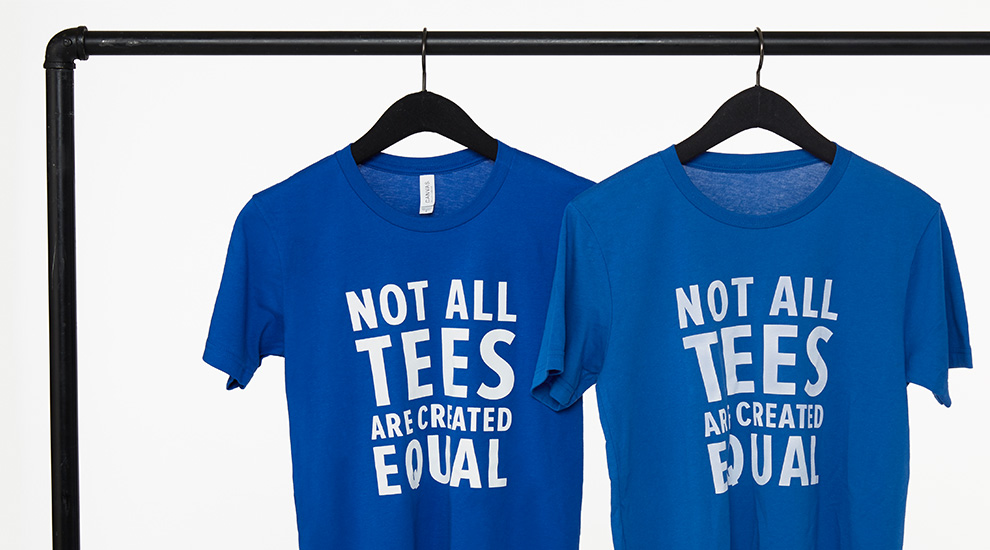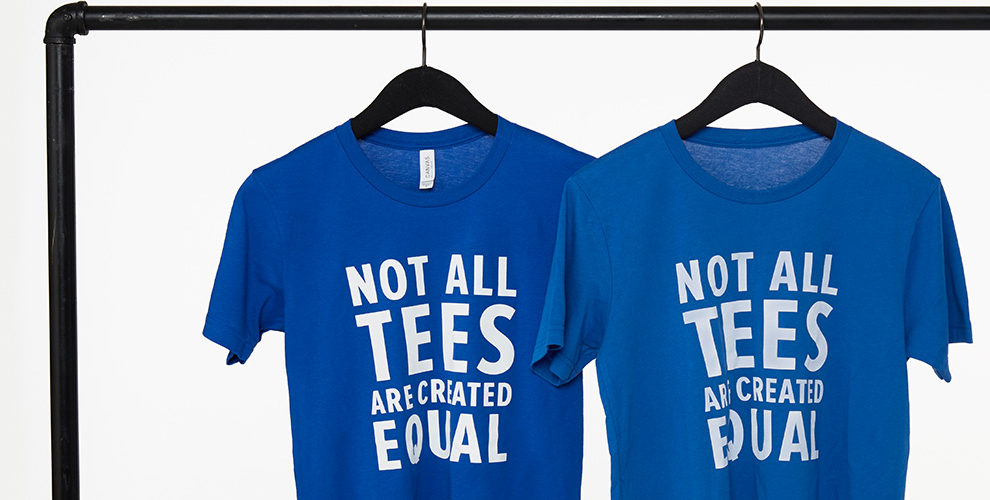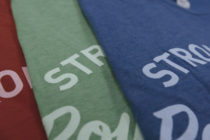Dye migration can be a real pain when it comes to decorating polyester. And while it can happen on just about any shade, generally speaking, the darker or brighter the hue, the more likely migration is to occur, but there are some simple tricks that will help you avoid dye migration for good.
Dye migration happens when dyes in specific fabrics are activated when they’re exposed to the heat. It works like this: during the heat-printing process, inks can often bleed through lettering, and screen printed or heat transferred designs. This not only makes for an annoying mess, but it also ruins the fabric you’re working with. No fun!
How to Avoid Dye Migration on Polyester
At BELLA+CANVAS, we take necessary steps during the dye process to create garments that are less likely to experience dye migration when they are printed. High quality dyes lead to better printing, so we never cut corners to shave costs when dying our fabric. In addition to choosing high quality garments when printing, there are several steps you should follow to avoid dye migration.
- First, test it out. It’s easy to test for dye migration by simply covering the garment with a kraft paper cover sheet and applying it for 10 seconds with a heat press. If a dye’s unstable, you’ll instantly see ink residue on the cover sheet.
- Next, scope out the scene. Look for products that have dye-blocking capabilities. Terms such as: high opacity, opaque, blocks dye migration, for darks, low-bleed, bleed-resistant, or dye-inhabiting mean you’re good to go.
- We also suggest asking for a sample before purchasing a specific material for your job. It’s best to test one item before purchasing an entire quantity so you don’t end up with a bunch of stuff you can’t use. Apply your design to the fabric and let it sit for up to 24 hours. If it hasn’t bled through, order away – you’re good to go!
- Last but definitely not least, even the best dye-blocking materials may not work on some fabrics. The dye process tends to change dependent on the manufacturers, so be sure to always test your heat application. It’s simple: a few short minutes of testing can save you big bucks in the long run!
Test out our poly-blends and you’ll definitely notice a superior printing performance to other brands who do not invest in high quality dyes and fabrics. Any additional tips for dye migration? Leave them in the comment section!





13 Comments
Tudor Lloyd-Kerry
Some good advice here. I’d suggest leaving the printed fabric to one side for at least 2-3 days though. Dye migration can take that long on some fabrics. The worst culprits seem to be black, maroon and reds for us. We print onto custom made 100% polyester running tops every week. We use a very good dye-block white from our ink supplier and it works very well. My advice would be to get 3 different ink brand samples and p/f/p with all of them, then see which has the best block capabilities.
Another option would be to try a low cure additive in your plastisol. Dye migration only happens at a certain temperature (280 degrees +). If you can get the ink to cure low enough then dye is less likely to be extracted from the fabric. Low and slow is the secret when curing. You might even find it beneficial to have someone shaking out the garments at the other end to get the temperature down as quickly as possible. If the garments are sitting in a pile after they come out the dryer then migration is still possible if they’re hot.
BELLA+CANVAS
That’s an excellent tip, Tudor! The more measures taken during the testing process the better!
waterfallmagazine.com
https://waterfallmagazine.com
Hmm it seems like your site ate my first comment (it was super long) so I guess I’ll just
sum it up what I wrote and say, I’m thoroughly enjoying your blog.
I too am an aspiring blog writer but I’m still new to the whole thing.
Do you have any points for beginner blog writers? I’d definitely
appreciate it.
BELLA+CANVAS
Glad you are enjoying our blog! We suggest using the templates that companies like Word Press offer, they try to make it as seamless as possible! There are also tutorials on YouTube and other blogs to help you out. 🙂
masstamilan
We print onto custom made 100% polyester running tops every week. We use a very good dye-block white from our ink supplier and it works very well. My advice would be to get 3 different ink brand samples and p/f/p with all of them, then see which has the best block capabilities.
BELLA+CANVAS
Thanks so much for sharing this tip!
word counter
Your article is extremely attractive and interesting, hopefully more people will know and visit your blog
BELLA+CANVAS
Thanks for your positive feedback!
sam
Thanks a lot for good post here
BELLA+CANVAS
Glad you enjoyed it!
MyLittleOne.Photography
Thanks for sharing such a nice article.
Smm Panel
Really useful article, thanks for sharing this information with us.
BELLA+CANVAS
Glad you enjoyed it!